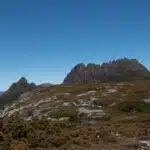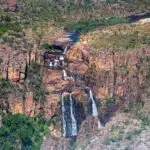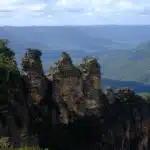Uluru-Kata Tjuta National Park, located in the heart of Australia’s Red Centre, is one of the country’s most iconic and culturally significant destinations. This UNESCO World Heritage site is renowned for its striking natural formations, deep spiritual connections to the Anangu people, and breathtaking desert landscapes.
The Majestic Uluru
Uluru (Ayers Rock) is one of the world’s most recognizable natural landmarks. Standing 348 meters tall and stretching over 9 kilometers in circumference, this massive sandstone monolith changes color dramatically depending on the time of day, shifting from deep red to glowing orange and purple at sunset and sunrise. Uluru is a sacred site to the Anangu, the traditional owners of the land, and their stories are deeply intertwined with its creation.
Visitors can explore the base of Uluru on foot via the Uluru Base Walk, which offers a close-up view of ancient rock formations, hidden caves, and rock art sites that reveal thousands of years of Indigenous culture and history. For a deeper understanding, guided tours led by local Indigenous guides provide insights into the spiritual significance of the rock and the stories of Tjukurpa, the traditional law and culture of the Anangu people.

The Enigmatic Kata Tjuta
Located 50 kilometers west of Uluru, Kata Tjuta (The Olgas) is a collection of 36 dome-shaped rock formations. Kata Tjuta is just as spiritually important as Uluru, with several sacred sites that are integral to Anangu culture. The domes are taller than Uluru, with Mount Olga reaching 546 meters in height.
Visitors can explore the unique formations by walking the Valley of the Winds Trail, a 7.4-kilometer loop that offers stunning views of the domes and the surrounding desert. This hike takes you through ancient landscapes, rugged gorges, and offers panoramic views of the outback’s vastness. For a shorter option, the Walpa Gorge Walk is a 2.6-kilometer track that leads through a serene and shaded gorge between two of the largest domes.


Cultural and Spiritual Significance
Uluru-Kata Tjuta National Park is not just a natural wonder; it is a deeply spiritual place for the Anangu people, who have lived in this region for tens of thousands of years. The park is a living cultural landscape, and visitors are encouraged to approach it with respect and a sense of reverence. Signs throughout the park provide information about its cultural significance, and visitors are asked not to climb Uluru, out of respect for the Anangu’s wishes.
The Cultural Centre, located within the park, is a must-visit for anyone wanting to learn more about the Anangu people and their connection to the land. Here, you can explore exhibits, watch cultural demonstrations, and purchase authentic Indigenous art and crafts.
Stunning Sunrises and Sunsets
One of the highlights of visiting Uluru-Kata Tjuta National Park is witnessing the ever-changing colors of Uluru at sunrise and sunset. Viewing platforms are strategically placed to offer the best perspectives as the rock transforms before your eyes, glowing in vivid hues that seem almost surreal. The sunsets and sunrises at Kata Tjuta are equally mesmerizing, with the domes bathed in soft light as the sun moves across the sky.
Be sure to bring your camera and set aside time to experience these awe-inspiring moments, as they are truly some of the most magical sights in Australia.
When to Visit
The best time to visit Uluru-Kata Tjuta National Park is during the cooler months from May to September. During this time, daytime temperatures are more comfortable for exploring the desert landscapes, with highs around 20–30°C (68–86°F). However, be prepared for cold nights and early mornings. The summer months (December to February) can be extremely hot, with temperatures soaring above 40°C (104°F).
Tips for Visiting Uluru-Kata Tjuta National Park
- Respect the Culture: Be mindful of the Anangu’s cultural and spiritual beliefs. Follow park guidelines, especially around areas considered sacred, and do not climb Uluru.
- Stay Hydrated: The desert can be harsh, so bring plenty of water and wear a hat and sunscreen to protect yourself from the sun.
- Explore with a Guide: Guided tours, especially those led by Indigenous guides, offer a richer understanding of the park’s cultural and spiritual significance.
- Accommodation: Options range from campsites and basic lodges to luxury hotels in nearby Yulara, about 20 kilometers from Uluru. Be sure to book in advance, especially during peak seasons.
- Park Pass: To enter Uluru-Kata Tjuta National Park, you’ll need a park pass, which can be purchased online or at the entrance. Passes are valid for three days, allowing you ample time to explore both Uluru and Kata Tjuta.
A Journey Like No Other
Uluru-Kata Tjuta National Park offers visitors a chance to connect with Australia’s ancient landscapes and Indigenous culture in a deeply meaningful way. The grandeur of Uluru and Kata Tjuta, combined with the profound spiritual significance of the area, makes this national park one of the most extraordinary places in the world. Whether you’re watching the sun set over the desert or learning about the land from its traditional custodians, a visit to Uluru-Kata Tjuta will leave you with memories that last a lifetime










